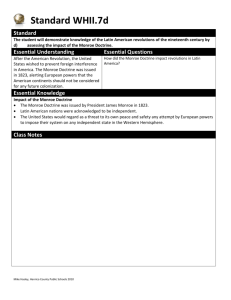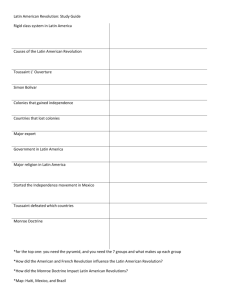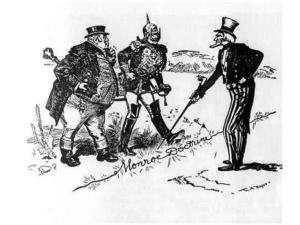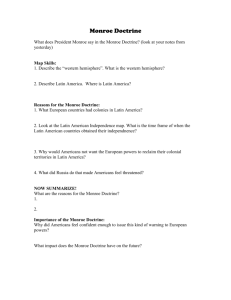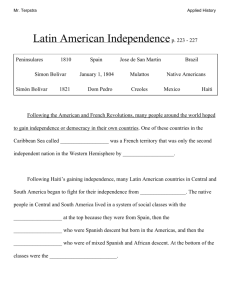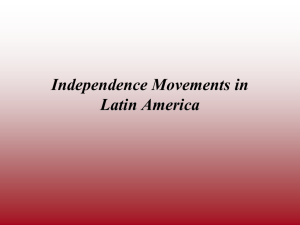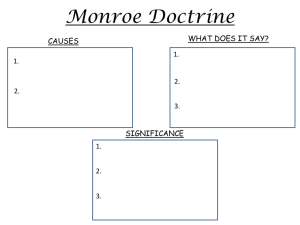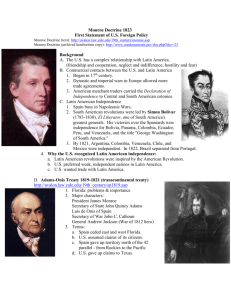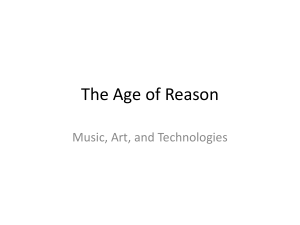Results of Independence Movements in Latin America
advertisement
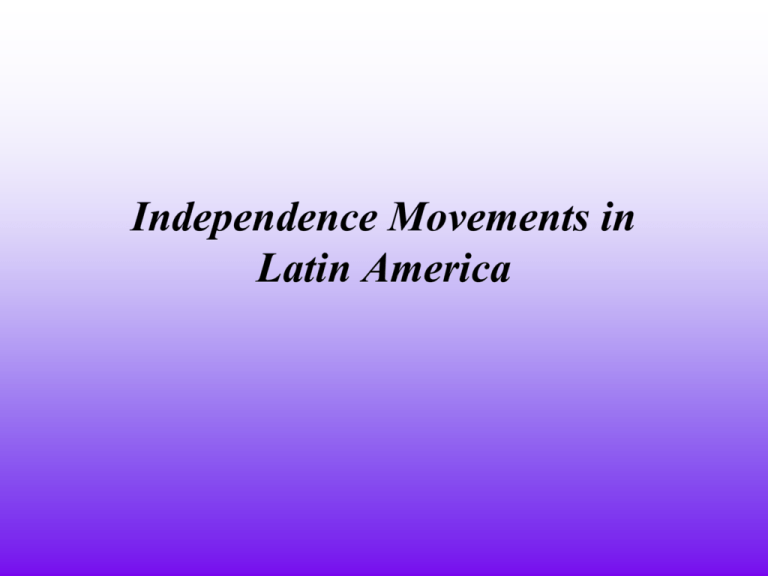
Independence Movements in Latin America Introduction The American and French Revolutions took place in the late 1700s. Within twenty years, the ideas and examples of these revolutions influenced the people of Latin America to establish independent nations, most notably in Haiti and Mexico. Who controlled the New World? Vocabulary The separation of the various peoples in the Latin American colonies created a very intricate list of names to describe one's precise race and one's place in society. Peninsulares-born in Spain, held highest positions in colonial government and Catholic Church. Think: Iberian Peninsula. Creole- American born descendants of Spanish settlers, owned most of the plantations, ranches and mines. Treated as second class citizens. Vocabulary Mestizo- Native American and European descendant Mulatto- African and European descendant African and Native American descendant were the lowest social class Enslaved Africans- worked on plantations and longed for freedom. Toussaint L’Ouverture-Haiti Toussaint was born a slave and then granted his freedom in 1777. He was inspired by revolutions in France and the United States. In 1791 the slaves of Hispaniola (now Haiti) rose up in revolt. Toussaint became the valiant general who led the revolt. Toussaint L’Ouverture Results: Toussaint succeeded in defeating the European powers who controlled Hispaniola: Spain, France, and Britain. Slavery was abolished Independence for Haiti. The Haitian Revolution 1791–1804 Very brutal insurrection Miguel Hidalgo-Mexico Catholic priest who was a leader of the revolt that sparked the Mexican War for Independence Ignited uprising of poor Mexicans (indigenous and mestizo peasants) against Spanish ruling class (peninsulares) Mexican War of Independence In the small town of Dolores, near Guanajuato in Mexico, on September 16, 1810 Father Hidalgo rang the church bells to call his parishioners. “el Grito de Dolores” or “the cry of Dolores” became the call to fight for Mexican independence. This event marked the beginning of the Mexican War of Independence from Spain. Father Jose Morelos Morelos picked up the banner of revolution in Mexico after Hidalgo was executed. Morelos was a mestizo Wanted to improve conditions, abolish slavery, give vote to all men. Captured, shot and killed in 1815. Mexican Independence Mexican Independence was finally achieved in 1821. Mexican Independence from Spain is NOT Cinco de Mayo! The 5th of May celebrates the win of the Mexican Militia over the French Army at The Battle Of Puebla in 1862. Simon Bolivar Known as “el Libertador” Educated creole who dreamed of independence from Spain. Traveled to Europe and was inspired by Enlightenment ideas and revolution. Through fierce and bloody battles he freed Venezuela, Colombia, Panama, Ecuador, Peru and Bolivia from Spanish rule. José de San Martín Was born a creole but went to Europe for military training. Freed Argentina, and Chile and Peru from Spain. Prince Dom Pedro Dom Pedro was the son of the King of Portugal. The Portuguese royal family fled to Brazil when Napoleon’s army conquered Portugal. When the family went back to Portugal Dom Pedro was left to rule Brazil. Dom Pedro became ruler of an independent Brazil with a constitution. Results of Independence Movements in Latin America Democracy failed to take hold in the new countries, wealth and power remained in the hands of a few. Twenty separate nations emerged. Most wrote up constitutions modeled after the United States. Trade with United States and Great Britain became the main source of revenue. Monroe Doctrine 1823 Latin American nations were acknowledged as independent by the United States. Spain made moves to win her colonies back. British leaders asked President Monroe to join in a statement opposing new colonization of the Americas. Monroe Doctrine 1823 Issued by American President James Monroe in 1823 Primary Objective: to ensure the freedom of newly independent countries of Latin America and keep them safe from European intervention and control. The Monroe Doctrine European efforts to colonize land or interfere within the Americas would be viewed by U.S. as acts of aggression requiring US intervention. Asserted that the Western Hemisphere was not to be further colonized by European countries. The United States began its own imperialism in 1848 as a result of a war with Mexico. What do you see here? The Monroe Doctrine Explanation on following slide. Allyn Cox, Oil on Canvas, 1973-1974 Responding to Russian territorial claims along the northern Pacific coast, and concerned that European nations would attempt to seize recently independent Latin American states, President James Monroe announced a new national policy. No new colonies would be allowed in the Americas, and European powers were not to interfere in the affairs of the Western Hemisphere. This mural depicts a discussion among the president and members of his cabinet; from left to right are President James Monroe, Secretary of State John Quincy Adams, Attorney General William Wirt, Secretary of War John Calhoun, and Secretary of the Navy Samuel L. Southard. http://www.aoc.gov/cc/art/cox_corr/g_exp/monroe.cfm?closeup=1 Independence in Latin America How did the French and American Revolutions influence Latin American independence movements? Influence of the American and French Revolutions on the Americas Slaves in Haiti rebelled, abolished slavery, and won independence. Father Miguel Hidalgo started the Mexican independence movement. Independence came to French, Spanish, and Portuguese colonies. Locations of selected countries that gained independence during the 1800s The contributions of Toussaint L’Ouverture and Simon Bolivar, led to the development of independent states in Latin America in the nineteenth century. What were the contributions of Toussaint L’Ouverture and Simon Bolivar to revolutions in Latin America? Monroe Doctrine After the American Revolution, the United States wished to prevent foreign interference in America. The Monroe Doctrine was issued in 1823, alerting European powers that the American continents should not be considered for any future colonization. How did the Monroe Doctrine impact revolutions in Latin America? Monroe Doctrine was issued by American President, James Monroe in 1823. Latin American nations were acknowledged to be independent. The United States would regard as a threat to its own peace and safety any attempt by European powers to impose their system on any independent state in the Western Hemisphere. What influenced the people of Latin America to establish independent nations? The Latin American colonies of what three nations rebelled as a result of the American and French revolutions? Who led the rebellion in Haiti? Who led the revolutions in South America?
